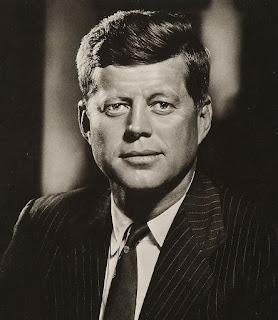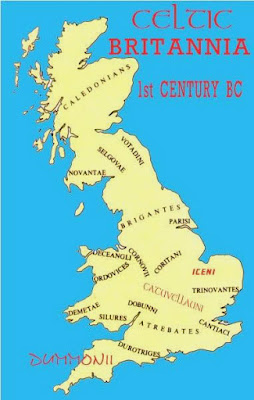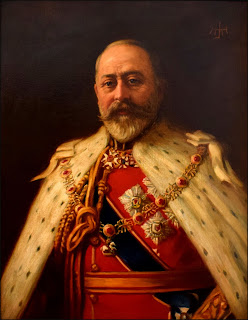Last 2 Blog Entries
Historical and Cultural Landmarks
WWI
World War I, also known as the Great War, was a conflict that happened in its majority in Europe that lasted from the 11th July 1914 to the 11th November 1918, that confronted two allied sides.
On the first side, we had the triple ally of Germany, Austri-Hungary and Italy, and on the other side, Great Britain, France and the Russian Empire.
This war supposed the loss of approximately 9 million of soldiers added to 7 million of civilians. Britain registered a total of 700.000 people between soldiers and missing people.
After the War, Great Britain went from being the biggest investor in Europe to being the biggest debtor.
Roaring twenties (American Dream)
Wall Street Crash/The depression
Wall Street Crash & The Great Depression
WWII
Cold War
JOHN
FITZGERALD KENNEDY
Early life
Kennedy was born on 29th
May, 1963 in Brookline, Massachusetts. He grew up in a wealthy and powerful
political family, and he had 3 brothers and 5 sisters.
John graduated from Harvard in 1940
with honours. Then, he travelled to Great Britain to be with his father who was
the U.S. Ambassador to Great Britain at the time. He tried to join the army but
couldn't get in because he had a bad back. So, he joined the Navy and was in
command of a patrol torpedo boat when it was sunk but he survived. Sadly, his
older brother Joe wasn't as lucky and died in combat during the war.
Before
becoming President
When his brother died, his father got
John involved in politics and helped John get elected to the U.S. Congress in
1947. He was congressman for 6 years and then became senator in 1953.
He ran for president in 1960 against
Nixon in a very close election. When Kennedy was elected he gave a very
memorable speech: Ask not what your
country can do for you, ask what you can do for your country.
His presidency was marked by the Cold
War and the Cuban Missile Crisis.
His death
The president was travelling all
along the US for the presidential run, and when he was killed, he was in a
parade at Dallas (Texas). The car turned off Main
Street at Dealey Plaza around 12:30 p.m. As it was passing the Texas School
Book Depository, gunfire suddenly reverberated in the plaza.
Bullets struck the president's neck
and head and he slumped over toward Mrs. Kennedy. The Governor was also hit in
the head. At 1:00 p.m. John F. Kennedy was pronounced dead.
Less than an hour earlier, police had
arrested Lee Harvey Oswald, a recently hired employee at the Texas School Book
Depository. He was being held for the assassination of President Kennedy and
the fatal shooting on a Dallas street.
On Sunday morning, November 24th,
Oswald was scheduled to be transferred from police headquarters to the county
jail. Viewers across America watching the live television coverage suddenly saw
a man aim a pistol and fire at point blank range. The assailant was identified
as Jack Ruby, a local nightclub owner. Oswald died two hours later at Parkland
Hospital.
 Black and African Americans constitute the third largest racial and ethnic group in the United States (after White Americans and Hispanic and Latino Americans). Most African Americans are descendants of enslaved peoples. On average, African Americans are of West/Central African and European descent, and some also have Native American ancestry. According to US Census, African immigrants generally don’t self-identify as African American.
Black and African Americans constitute the third largest racial and ethnic group in the United States (after White Americans and Hispanic and Latino Americans). Most African Americans are descendants of enslaved peoples. On average, African Americans are of West/Central African and European descent, and some also have Native American ancestry. According to US Census, African immigrants generally don’t self-identify as African American.
NATIVE AMERICANS
Native Americans are the indigenous peoples of the United States. There are over 500 federally recognized tribes within the U.S., about half of which are associated with Indian reservations.
The ancestors of modern Native Americans arrived in what is now the United States at least 15,000 years ago, possibly much earlier, from Asia via Beringia. A vast variety of peoples, societies and cultures subsequently developed.
Native Americans were greatly affected by the European colonization of the Americas, which began in 1492, and their population declined precipitously due to introduced diseases, warfare, and slavery. After the founding of the United States, many Native American peoples were subjected to warfare, removals, and one-sided treaties, and they continue to suffer from discriminatory government policies today. Since the 1960s, Native American self-determination movements have resulted in many changes to the lives of Native Americans, though there are still many contemporary issues faced by Native Americans. Today, there are over five million Native Americans in the United States.
Asia-Americans
According to the Census Bureau, are those who are Cuban, Mexican, Puerto Rican, South or Central American or Spanish.
In 2016, over 55 million latinos lived in United States, representing the 17% of the total population of the USA (119 million).
There are a few states that have a large number of Hispanic people living in, like California for example, with a 38.6% of latin people. Others like Texas and New Mexico have too a big number of latin people living in.
In most parts of the world, primary education is the first stage of compulsory education, it is normally available without charge, but may be offered in a fee-paying independent school. The term grade school is sometimes used in the US, although this term may refer to both primary education and secondary education.
Aim
Primary school education today is focussed on establishing the fundamental literacy and numeracy skills of children, as well as developing their understanding of the world. These skills are increasingly necessary for life in the modern world, and are essential to the functioning of developed economies. For this reason, primary education is compulsory and provided by the state in almost all countries around the world.
The second United Nations Millennium Development Goal was to "ensure that, by 2015, children everywhere, boys and girls alike, will be able to complete a full course of primary schooling." This goal was missed but significant progress has been made. In 1970, 28% of primary-school- age children in the world were not attending school, today this share has decline to 9% -- equivalent to 60 million children not in primary education.
United Kingdom
Organization
·Early childhood education at preschool, nursery school, or kindergarten (outside the U.S. and California)
·Primary education at primary school or elementary school, and sometimes I the early years of middle school.
·Secondary education at secondary school or hight school, and sometimes in the latter years of
middle school.
·Higher education or vocational education.
Contemporary Society
- Regionalism
Inmigration and ethnicity
AFRICAN AMERICANS
African Americans are an ethnic group of Americans with total or partial ancestry from any of the black racial groups of Africa.
 Black and African Americans constitute the third largest racial and ethnic group in the United States (after White Americans and Hispanic and Latino Americans). Most African Americans are descendants of enslaved peoples. On average, African Americans are of West/Central African and European descent, and some also have Native American ancestry. According to US Census, African immigrants generally don’t self-identify as African American.
Black and African Americans constitute the third largest racial and ethnic group in the United States (after White Americans and Hispanic and Latino Americans). Most African Americans are descendants of enslaved peoples. On average, African Americans are of West/Central African and European descent, and some also have Native American ancestry. According to US Census, African immigrants generally don’t self-identify as African American.
The majority of African immigrants identify with their own respective ethnicities (~95%).
African-American history starts in the 16 th century, with people from West Africa taken as slaves to Spanish America, and in the 17 th century with West African slaves taken to English colonies in North America. After the founding of the United States, black people continued to be enslaved, and the last four million black slaves were only liberated after the Civil War in 1865. Due to notions of white supremacy, they were treated as second-class citizens. The Naturalization Act of 1790 limited U.S. citizenship to whites only, and only white men of property could vote.
These circumstances were changed by Reconstruction, development of the black community, participation in the great military conflicts of the United States, the elimination of racial segregation, and the civil rights movement which sought political and social freedom. In 2008, Barack Obama became the first African American to be elected President of the United States.
NATIVE AMERICANS
Native Americans are the indigenous peoples of the United States. There are over 500 federally recognized tribes within the U.S., about half of which are associated with Indian reservations.
The ancestors of modern Native Americans arrived in what is now the United States at least 15,000 years ago, possibly much earlier, from Asia via Beringia. A vast variety of peoples, societies and cultures subsequently developed.
Native Americans were greatly affected by the European colonization of the Americas, which began in 1492, and their population declined precipitously due to introduced diseases, warfare, and slavery. After the founding of the United States, many Native American peoples were subjected to warfare, removals, and one-sided treaties, and they continue to suffer from discriminatory government policies today. Since the 1960s, Native American self-determination movements have resulted in many changes to the lives of Native Americans, though there are still many contemporary issues faced by Native Americans. Today, there are over five million Native Americans in the United States.
Asia-Americans
Hispanic/latinos
According to the Census Bureau, are those who are Cuban, Mexican, Puerto Rican, South or Central American or Spanish.
In 2016, over 55 million latinos lived in United States, representing the 17% of the total population of the USA (119 million).
There are a few states that have a large number of Hispanic people living in, like California for example, with a 38.6% of latin people. Others like Texas and New Mexico have too a big number of latin people living in.
Education
Primary and SecondaryIn most parts of the world, primary education is the first stage of compulsory education, it is normally available without charge, but may be offered in a fee-paying independent school. The term grade school is sometimes used in the US, although this term may refer to both primary education and secondary education.
Aim
Primary school education today is focussed on establishing the fundamental literacy and numeracy skills of children, as well as developing their understanding of the world. These skills are increasingly necessary for life in the modern world, and are essential to the functioning of developed economies. For this reason, primary education is compulsory and provided by the state in almost all countries around the world.
The second United Nations Millennium Development Goal was to "ensure that, by 2015, children everywhere, boys and girls alike, will be able to complete a full course of primary schooling." This goal was missed but significant progress has been made. In 1970, 28% of primary-school- age children in the world were not attending school, today this share has decline to 9% -- equivalent to 60 million children not in primary education.
First Primary Education System
The earliest universal primary education system was established in Prussia by Frederick William in 1717. It was greatly expanded during the first half of the 19th Century and later copied by other European nations and the US. While many countries followed suit during the 20th century, others have been much slower at adopting the model of universal education. India only passed laws introducing universal, free and compulsory education in 2009. There also still remain a handful countries that do not have laws making attendance mandatory.
In England and Wales education is divided into two stages: primary education and secondary education.
Required assessment within the National Curriculum takes place in years 2 and 6 (National Curriculum assessments) and Year 11 (GCSEs). School education is generally followed by two years of further education – often in a 6th form or 6th form college and then three or four years at university by those who decide to stay in education.
Secondary education is compulsory to the age of 16. Schools have various possible names, such as grammar, comprehensive and secondary schools, which may or may not indicate selective admission or tuition fees.
Organization
·Early childhood education at preschool, nursery school, or kindergarten (outside the U.S. and California)
·Primary education at primary school or elementary school, and sometimes I the early years of middle school.
·Secondary education at secondary school or hight school, and sometimes in the latter years of
middle school.
·Higher education or vocational education.




Comentarios
Publicar un comentario